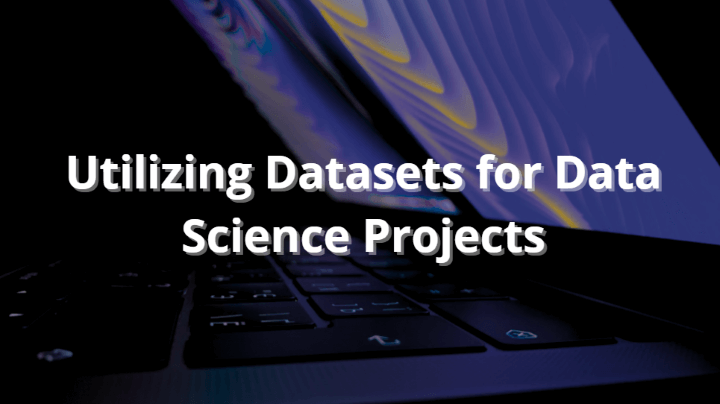The Ultimate Guide to Utilizing Datasets for Data Science Projects

Data science projects can be both exhilarating and daunting. The internet offers countless datasets, so finding the right ones for your project seems impossible. If you’re delving into advanced science projects, it’s crucial to understand how to leverage these datasets effectively.
This guide aims to demystify the process, providing you with the knowledge to harness information for insightful, impactful project work.
What Are Datasets?
A dataset is a collection of data points, organized in a structured format, typically as tables with rows and columns in CSV files. For computer vision tasks, datasets consist of image collections. They serve as the foundation for analyzing patterns, testing hypotheses, and building predictive models.
Types of Datasets
These are the backbone of data analysis, serving as the raw material from which insights and knowledge are derived. They can be broadly categorized into several types based on the nature of the information they contain and their structure.
The major types of datasets include numerical, categorical, time-series, and spatial datasets, each with unique characteristics and applications:
- Numerical: Consists of quantitative information that can be measured on a numerical scale, such as age or income.
- Categorical: Contains qualitative information that describes characteristics, such as gender or race, and can be nominal or ordinal.
- Spatial: Involves location-based information, such as maps or GPS data, and can vary in structure.
Beyond these types, datasets can also be distinguished by their source (public or private), format (file-based, database, web dataset), and whether they are structured or unstructured.
Public sets of information, in particular, are invaluable for research and development, offering a rich resource for scientists to explore and analyze.
Where to Find Datasets for Data Science Projects
Several platforms and repositories provide access to a wide range of datasets suitable for various disciplines. Here are some notable sources:
Government and International Organizations
- Data.gov
This is the U.S. government’s open platform, offering a vast repository of federal datasets covering everything from agriculture and finance to health and science. It’s a primary source for public information, facilitating research, application development, and academic projects.
- The World Bank Open Data
Free and open access to information about global development is the hallmark of this platform. It features datasets on a wide array of topics, from economic indicators to health care. If you aim to address global challenges, the World Bank Open Data is the right choice.
Specialized Data Repositories
- Kaggle
Kaggle hosts an extensive collection of information provided by users and organizations. It covers a wide range of topics suitable for machine learning and data analysis projects. With it, you can carry out any project, from sentiment analysis to image recognition.
- UCI Machine Learning Repository
This is a longstanding resource in the machine learning community. It offers stats specifically curated for machine learning tasks. Mostly, this repository is used for projects in bioinformatics, robotics, and social sciences.
- Google Dataset Search
Google Dataset Search allows users to find information stored across the web. It leverages the power of Google’s search capabilities and provides access to millions of datasets. Here you can find any subject, sourced from academic publishers, government databases, and other organizations.
Health and Science
- The World Health Organization (WHO)
WHO provides access to a wealth of health-related information. Its datasets include information on global health observatories, disease outbreaks, and vaccination rates. Also, they support research and policy-making in public health.
- Centers for Disease Control and Prevention (CDC)
The CDC offers datasets on health indicators, diseases, and conditions in the United States and globally. It’s instrumental for epidemiological research and health trend analysis.
Finance
- Nasdaq Data Link
This platform offers a comprehensive suite of financial bases, including stock prices, economic indicators, and investment analytics. It’s an essential resource for anyone involved in financial analysis, economic research, or trading strategy development.
Film and Media
- The British Film Institute (BFI)
The BFI’s database provides a wide range of datasets related to the film and television industry. Here you can find box office statistics, filmography stats, and audience research. It’s a valuable resource for analyzing trends, audience preferences, and the economic aspects of the film industry.
Utilizing Datasets in Data Science Projects

The application of datasets in science projects involves several stages, from data cleaning to exploratory data analysis. Each stage requires a thoughtful approach to ensure the information is accurately represented and analyzed.
Data Cleaning
The foundation of any data science project is built on the quality of the data at hand. Data cleaning is the essential first step that ensures this foundation is solid. It involves a series of actions aimed at correcting errors and inconsistencies within the dataset, such as:
- Duplicates Removal: Identifying and eliminating duplicate records to prevent skewed analysis results.
- Handling Missing Values: Deciding on strategies for dealing with missing information, whether by imputation, deletion, or estimation.
- Correction of Inaccuracies: Verifying the dataset for errors in information entry or measurement and rectifying them to ensure accuracy.
- Format Standardization: Ensuring that all stats follow a uniform format for seamless analysis, such as converting all dates to a single format.
Exploratory Data Analysis (EDA)
Once the dataset is clean and structured, the next phase is EDA. It is a critical exploratory phase that allows scientists to dive deep into the dataset. EDA is characterized by:
- Pattern Recognition: Identifying patterns or trends within the statistics that may indicate correlations or causations.
- Anomaly Detection: Spotting outliers or anomalies that could signify errors or important, rare events.
- Understanding Relationships: Analyzing the relationships between variables to uncover potential dependencies or interactions.
- Visualization: Employing graphical representations such as histograms, scatter plots, and box plots to visualize info distributions and relationships.
Model Building
This phase involves applying machine learning algorithms. Scientists develop models for making predictions or classifications based on the input information. Key aspects include:
- Selection of Algorithms: Choosing the most appropriate machine learning algorithms based on the problem statement and the nature of the data.
- Training the Model: Feeding the cleaned and processed dataset into the model to “learn” from the data.
- Validation and Testing: Evaluating the model’s performance using a separate dataset not seen by the model during training.
- Iteration: Refining the model through multiple iterations, tweaking parameters, and possibly revisiting the EDA phase.
The Role of Proxies in Data Science Projects

Proxies offer solutions for enhanced privacy, unrestricted access, and scalable data collection. Here is how proxies contribute to the efficiency and effectiveness of projects.
Find the best proxy provider that will suit your project needs.
Enhancing Privacy and Security through Proxies
- Privacy Protection
Proxies maintain the privacy of scientists. They conceal their IP addresses and prevent unauthorized parties from tracking their online activities.
- Risk Mitigation
The use of proxies reduces the risk of sensitive information being stolen. They provide the layer of security that is crucial for protecting personal information.
- Avoid Detection
Proxies mask the origin of requests, making it difficult for web servers to detect and block these requests. This allows scientists to gather information without the risk of being restricted or banned by the target website.
- Maintain Access
For projects that depend on the latest information from the web, proxies ensure uninterrupted access to public sources. This continuous access is vital for projects that require up-to-date info for analysis and decision-making.
Overcoming Geographical Restrictions
- Global Reach
With proxies, you can route requests through servers located around the globe. This allows access to region-specific datasets that would otherwise be out of reach, due to restrictions imposed on certain locations.
- Diverse Data Collection
The global reach significantly broadens the spectrum of information available for collection. This diversity enriches the datasets scientists can analyze, offering a more varied and comprehensive pool of data for research and analysis.
- Enriches Research
Datasets from different geographical regions enrich the understanding of global trends and patterns. It enhances the depth and breadth of research findings, providing insights that are reflective of a wider range of perspectives and conditions.
- Model Accuracy Improvement
Access to a broader array of stats through proxies improves the accuracy of predictive models. Training models on a diverse set of points ensures that the models are more adaptable and can accurately predict outcomes across different scenarios.
What is geo-spoofing? Learn how to circumvent geo-restrictions with proxies.
Scalability of Data Collection
- Requests Distribution
Proxies spread requests across multiple servers and effectively mitigate the risk of overloading any single server. It helps avoid triggering rate limits and bans that websites impose to protect against excessive access.
- Ensuring Reliability
The use of intermediaries can help to maintain a steady and uninterrupted flow of data. They circumvent blocks and avoid interruptions, ensuring that collection efforts remain consistent. This reliability is vital for projects that are time-sensitive or require large volumes of information.
- Comprehensive Data Gathering
Proxies facilitate extensive data collection for deep analysis and comprehensive insights. This is essential for projects that rely on a broad dataset for accurate and meaningful analysis, such as those involving market trends, consumer behavior, or global events.
- Enhanced EDA and Modeling
The rich datasets are invaluable for exploratory data analysis (EDA) and the development of machine learning models. With such a variety of stats, scientists can conduct thorough EDAs and enhance the accuracy and predictive power of machine learning models as well.
Learn about advanced techniques for optimizing proxy chains in high-volume scraping.
Conclusion
By understanding how to effectively find, clean, and analyze these datasets, you can unlock valuable insights and contribute to the advancement of knowledge across various fields. Whether you’re aiming to improve business strategies, contribute to scientific research, or explore societal trends, the right dataset can be your gateway to discovery.
